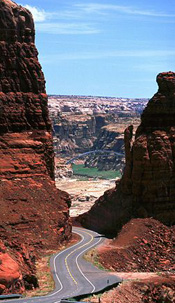
The strata of Glen Canyon as seen from Hite Crossing Bridge in Northern Arizona. |
Applying Superposition
You know from the principle of superposition that the bottom rock layer is the oldest layer in this rock body. You also know that the layers get progressively younger as you move upward. This image shows the layers in Glen Canyon, Arizona, where scientists doing field research have determined that the sedimentary rocks on the bottom are mostly coarse-grained sandstones. The layers become progressively finer-grained as you get closer to the top of the cliff. These rock layers:
- get younger from bottom to top
- get more fine-grained from bottom to top
Coarse sediments are usually deposited in near-shore marine environments, where there is sufficient energy for them to drop out of water. Fine sediments are deposited in off-shore marine environments, where small particles slowly settle out of slow-moving water. (Think of the difference in wave energy near the shore as opposed to out in the middle of a quiet ocean—coarse grains settle out near the shore; fine grains settle out in the middle of the sea.)